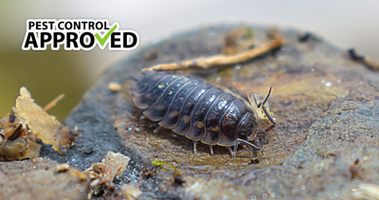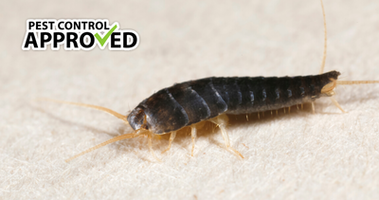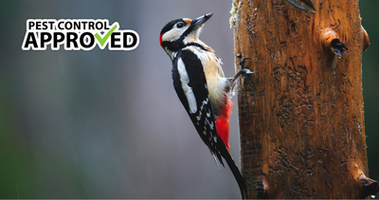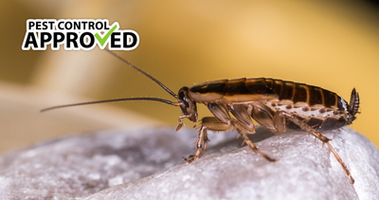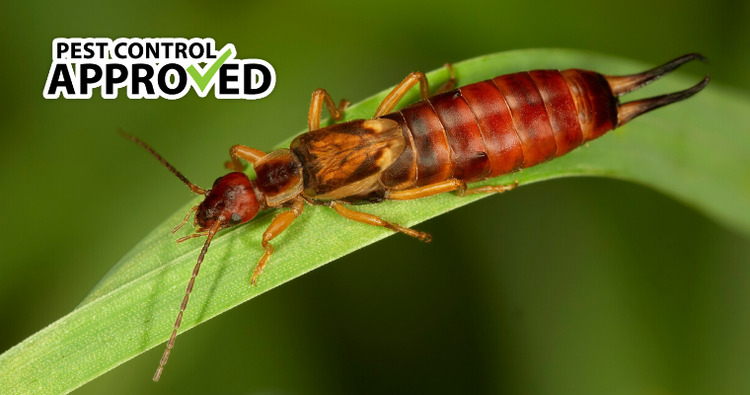
What Are Earwigs?
Earwigs belong to the insect order Dermaptera. Insects in this order are slender with elongated and flattened bodies. Earwigs can be easily identified by a pair of forceps-like pincers on their abdomens. Males have curved pincers while females have straight pincers. These pincers are used for self-defense and for catching prey. The length of an adult body ranges from a ¼ inch to an inch. They have six legs and a long pair of antennae that are half of their body’s length. Although they have short wings with hard wing covers, they seldom fly. They are commonly brown or black with reddish stripes.
Earwigs undergo an incomplete metamorphosis during their life cycle. They have five molts in the course of a year before they become adults. Unlike most insects, female earwigs exhibit maternal care and watch over the eggs until they are hatched and even look after young earwigs (nymphs) until their second mold. After the second molt, sexual differences begin to appear among the nymphs.
It is commonly said that earwigs crawl into your ears and lay eggs in your brain while you are sleeping. This is false. These nocturnal insects live in dark, cold places not warm human crevices. However, just like other insects, they can accidentally get into human ear canals.
Although they look ferocious, earwigs do not attack humans unless provoked. People may be pinched when they sit on or accidentally trap an earwig in their clothing. They also pinch when people try to capture them. However painful the bite may feel, no venom is transferred during the pinch and it does not break human skin.
Earwigs can be both harmful and helpful to your garden and vegetation. They are part of an insect group that contains sanitary engineers. They feed on dead material, thus aiding in decomposition.
Types of Earwigs
1. European Earwigs (Forficula Auricularia)
The most common type of earwig found in the United States is the European earwig. It is a nocturnal scavenger mostly inhabiting moist, dark, shady places. They always look for food and a safe environment. They feed on dead and decaying vegetation along with other insects. They are not harmful to humans; they just destroy garden life and vegetation. European Earwigs are most commonly found in gardens in the damp areas of your home such as your laundry room, basement, or wood pile.
2. Ring-Legged Earwigs
These earwigs are most commonly found in the Southern part of the United States. Unlike the European earwigs, they do not have wings. They are characterized by the reddish coloration of their bodies and their yellow legs. This species is slightly longer than common earwigs. Although they are mostly found outside in dead vegetation, they sometimes venture inside one’s house.
3. Striped Earwigs
These earwigs are known by multiple names: the earwig, the shore earwig, or the tawny earwig. They are most commonly known as the striped earwigs. They are distinguished by a pair of stripes on the front portion of their back. They possess a predatory nature and are mostly light brown in color. They are highly regarded for their pest control abilities as, apart from dead vegetation, they also feed on other insects. They can be useful for insect control.
4. Maritime Earwigs
These earwigs are most commonly found on the coast. These are predators that feed on insects present in the wet sand. Like other earwigs, they exhibit nocturnal characteristics and hunt for food at night. During the day, they hide in cool and moist places. They are similar in their exterior features to other insects. If you go for a picnic to the seaside and encounter one of these, don’t worry. These earwigs are harmless. They will not crawl inside your ear, unlike the myth.
5. Seashore Earwigs
These are cousins to the Maritime Earwig. These native insects of New Zealand and Australia hide under sand and stones. They are most commonly found along the shorelines of the beaches. They are a lighter brown near their head and a darker brown down their back to their tail. Like all other earwigs, they devour insects such as ants and fleas. These earwigs are not found in homes unless you live close to a shore. They can be carried into your house in clothing or beach things.
6. Saint Helena Earwigs
These earwigs are natives of Saint Helena island in the Atlantic Ocean. These earwigs are remarkably long. They can grow up to 3 inches and are often called the giant earwig. Due to changes in their environment, these earwigs are now extinct.
Where do Earwigs live?
Earwigs are nocturnal insects, which means that they hide during the daytime and search for food at night. They are most commonly found in your garden, under damp, soft, and moist plant mulch and vegetation. They can also be found under logs, stones, and dead leaves. They are huge fans of cellulose and can be found in between rotten logs.
How do Earwigs Get into Your House?
Earwigs are accidental invaders in your house. If the weather conditions remain dry and hot for a long period, they will come inside looking for cool indoor places. Damp weather after a rainy season can also make these earwigs come into your house. They are most commonly found in the crevices, cracks, basements, and water filled areas such as the laundry area, bathroom, and kitchen.
Remember, they are consume large amounts of cellulose, so they can be easily found near your old boxes, your favorite books or papers present in cooler places. In search of food, they can get into your kitchen and might infest food items. They are also attracted to lights and can gather quickly on your porch. Due to this attraction, they are often found stuck to the lit windows of your house.
Signs of Earwig Infestation in Your House?
Earwigs are non-venomous and generally don’t bite humans. But, none of us want to have them in our houses, sleeping in our basements, and infesting at our food at night. Due to their nocturnal nature, it is not always easy to discover if you have earwigs in your home. However, there are some signs that can be indicative of an earwig infestation:
- A foul and unbearable odor.
- Bite marks on your indoor plants.
- Damaged flower petals on living plants.
- The vegetables and fruits in your kitchen have holes and black marks.
- Earwig bites on humans or pets.
How do Earwigs Behave?
Earwigs are semi-social insects. This means that we can often see them gathering in large numbers. Earwigs, along with other insects, can damage your household plants. If you see significant damage in your plants, then you can hold them partially responsible. As they are nocturnal, they can be often found crawling in your house at night. A pair of earwigs can significantly and quickly increase their population in your house.
Are Earwigs Beneficial?
Although many people cringe at the name earwig, very few are really aware of their benefits. Earwigs are part of a group of insects are called sanitary engineers. As they are omnivorous, they can eat both plants and insects. Owing to their scavenger side, they feed onto insect eggs, larva, and sometimes adult insects.
They devour insects commonly found in your yard such as nematodes, slugs, mites, aphids and their eggs, and other soft-bodied insects. In a way, they act like pest control and can be left alone, unless they start attacking your plants.
How to get Rid of Earwigs?
Though earwigs are not harmful, many people do not want to have these creepy insects in their house. Moreover, it is not pleasant to have these insects crawling in your house, infesting your food, and destroying your indoor plants. There are multiple ways to get rid of earwigs, natural and chemical. Some of the remedies are mentioned below:
Natural Remedies
These are some of the easiest ways to remove earwigs from your house by using substances commonly found inside your house or at a home and garden store.
Natural Predators:
Natural predators are best for those who are worried about the adverse effects of a chemical spray or those who can’t fumigate due to kids, the elderly, or pets. Birds are natural wiping agents for these insects.
These birds feed on earwigs. This is the simplest and natural way to clear these earwigs out of your gardens. Since birds cannot smell an earwig’s foul odor, they can easily consume them. In order to attract birds, you should set up bird feeders in your garden. Spring is the best time to set up feeders because that is when earwig eggs hatch.
Diatomaceous Earth:
Diatomaceous Earth is a desiccant, which causes insects to lose moisture. It has a heightened effect on smaller creatures. With the help of a spreader, you can spread a fine layer all over your garden and the foundation of your house. The earwigs start losing their moisture as they start to crawl over this layer. The diatomaceous earth will kill the insects as they lose moisture through their eroding shell. This layer will also keep other insects from invading your house.
M-Pede Insecticidal Soap:
This soap is made up of potassium salts. It is a desiccating and smothering agent. It kills earwigs by suffocation and dehydration. The water blocks their tubes and the salt causes intense dehydration.
In a gallon of professional spray, mix 4-6 spoons of M-Pede Insecticidal soap. The ideal time to spray is before the sun rises when the temperature is cooler. Spray it underneath the leaves and on the dirt around the leaves. Do not forget to spray the foundation of your house, the crevices and cracks in your walls and cupboards, near pipelines and in the basement.
If you have woodpiles, old boxes, or books in storage, spray that area thoroughly. Be sure to spray garbage cans, rock mounds, leaf mulch, and litter. Spray every day until the earwigs disappear and then continue to spray for an additional week to prevent them returning.
Neem Oil:
Although it sounds like a folk remedy, neem oil is a repellent with fungicidal properties. It was used in India during ancient times to get rid of insects. Neem oil disturbs the hormonal balance of insects and hinders growth. In a spray bottle of 31 oz, take a quart of warm water and mix in one teaspoon of neem oil.
Spray this mixture in every spot where you have seen an earwig. Special attention should be given to leaky pipes, cracks and crevices, and all the entry points like windows and doors. With regular spraying over time, earwigs will disappear.
Petroleum Jelly:
If you want to save your favorite potted plants and fruit trees, use petroleum jelly. Apply petroleum jelly on the surface and stem of your plants. Petroleum jelly prevents these insects from climbing up the stem and ultimately saves your plants from being devoured.
Boric powder:
Those stacks of logs gathered in your backyard provides a cozy shelter for earwigs. They can easily creep into your house from these woodpiles. To prevent earwigs from infesting your woodpile, sprinkle boric powder over the woodpile.
Earwig traps:
Trapping is another useful strategy to contain an earwig infestation. Numerous traps should be placed in the garden or yard, against fences, and near shrubbery. An excellent trap can be set up by filling a low-sided can with cat food and a ½ inch of oil at the bottom. Vegetable oil and bacon grease or tuna fish oil can be also used. Place the can at soil level for excellent results. In the morning, you will see a bunch of captured earwigs, dump them and refill the can.
Other commonly used traps are:
- rolled-up newspaper
- corrugated cardboard
- bamboo tubes
- short piece of hose
Put these traps near plants on the soil and dump the collected earwigs into a dish of soapy water.
How an Exterminator treats Earwig infestation.
When these natural and chemical remedies do not bring about the desired result, you may need an exterminator. Whenever you hire a professional pest control company, ask the technician to inform you about the extent of infestation in your house. The pest removal service can take anywhere from a few minutes to several hours depending on the level of infestation, the size of the house, and the accessibility. They will charge you according to the above-mentioned factors. A reputable pest control company will provide further services if the earwigs are not wiped out in a single session.
How to Prevent Earwigs from Coming Back?
After you have gotten rid of these creepy insects, take care to prevent them from returning and infesting your house again. The following are ways to prevent earwigs returning.
Eliminate their Hideouts:
The First and foremost thing is to eliminate all the possible hideouts from your home and garden. Clearing up things will ventilate places and expose them to sunlight, thus diminishing the risk of earwigs.
Harborage Removal:
Suburbanites often decorate with ornamental rocks, patio stones, landscaping, mulch, picnic furniture, and decks. This setting unconditionally favors earwigs and provides them with everything needed to infest your home. It is important to take good care of this setting if you do not want a large population of earwigs.
Moreover, you need to eliminate outdoor harborages such as woodpiles, bricks, rocks, and piles of lumber. Vegetation that covers the ground should also be removed. Trees dangling over buildings and roofs should be adequately trimmed so that earwigs do not have access to your house.
Moisture Management:
Moisture attracts earwigs and can significantly increase their population in your yard. Moisture management is key to preventing earwigs from increasing their population. You should water your garden in the early morning, so that it can adequately dry out during the day. Furthermore, sprinklers should be used for vegetation and gardens to avoid excessive water accumulation.
People living in areas with naturally high humidity should try to control excessive humidity in their houses. This can be accomplished by a good dehumidifier.
Improve Sanitation:
Earwigs seek shelter in dark, shady, and moist places. One of the most popular places for them in your house is washrooms, kitchens, and laundry areas. Furthermore, female earwigs can lay eggs near flowing drainage and underneath leaking pipes. It is imperative to mend all pipes and leakages and avoid water seepage. Once there are no moist spots in your house, earwigs won’t be able to inhabit it.
Fortification of Your House:
Why is fortification necessary? Although most people live in a well-constructed apartment, townhouse, or bungalow, there are still places that insects can enter. In order to prevent the entry of earwigs, you should block all entry points of your house. Make sure to eliminate the space present under the door or in the window and ensure that none of the window shields are shattered or cracked.
In addition, vacuum your house regularly so that any earwigs can be quickly eliminated. With the help of caulking, seal up all the cracks, crevices, and fine lines in your walls and cupboards.
Lightning System:
The use of yellow bulbs on your porches and outdoor areas can prevent the earwigs from getting into your house. They are unable to see this color because of its frequency and will avoid these areas.
Conclusion
We have given you a detailed account of earwig infestations: what conditions favor their growth, and how to get rid of them. With proper steps and management, all homeowners can easily manage an infestation.


